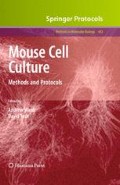Abstract
The gastrointestinal tract of vertebrates is lined by epithelium that develops from the endodermal germ layer. The oesophagus and intestine form part of the gastrointestinal tract and studying the normal development of both tissues is difficult due to lack of suitable in vitro model systems. One of the criteria for a reliable culture model includes the ability to carry out real-time observations in vitro. The method we describe here is based on the isolation of embryonic oesophagus and intestine from 11.5-day-old embryos and culture on fibronectin-coated coverslips in basal Eagle’s medium and 20% fetal bovine serum. This model permits real-time observations of both tissues and over a few days in culture, markers of differentiation appear. This culture system appears to recapitulate normal oesophagus and intestine development.
Access this chapter
Tax calculation will be finalised at checkout
Purchases are for personal use only
References
Slack, J. M. W. (2006) Development of endodermal organs. In Essential develop- mental biology, 2nd ed. Blackwell Scientific, Oxford, pp. 249–263.
Yu, W.-Y., Slack, J. M. W., and Tosh, D. (2005) Conversion of columnar to stratified squamous epithelium in the developing mouse oesophagus. Dev. Biol. 284, 157–170.
Duan, H., Gao, F., Li, S., and Nagata, T. (1993) Postnatal development and aging of esophageal epithelium in mouse: a light and electron microscopic radioautographic study. Cell. Mol. Biol. 39, 309–316.
Mathan, M., Moxey, P. C., and Trier, J. S. (1976) Morphogenesis of fetal rat duodenal villi. Am. J. Anat. 146, 73–92.
Marshman, E., Booth, C., and Potten, C. S. (2002) The intestinal epithelial stem cell. BioEssays 24, 91–98.
Hall, P. A., Coates, P. J., Ansari, B., and Hopwood, D. (1994) Regulation of cell number in the mammalian gastrointestinal tract: the importance of apoptosis. J. Cell Sci. 107, 3569–3577.
Strater, J., Koretz, K., Gunthert, A. R., and Moller, P. (1995) In situ detection of enterocytic apoptosis in normal colonic mucosa and in familial adenomatous polyposis. Gut 37, 819–825.
Tait, I. S., Evans, G. S., Kedinger, M., Flint, N., Potten, C. S., and Campbell, F. C. (1994) Progressive morphogenesis in vivo after transplantation of cultured small bowel epithelium. Cell. Transplant. 3, 33–40.
Hearn, C. J., Young, H. M., Ciampoli, D., Lomax, A. E., and Newgreen, D. (1999) Catenary cultures of embryonic gastrointestinal tract support organ morphogenesis, motility, neural crest cell migration, and cell differentiation. Dev. Dyn. 214, 239–247.
Abud, H. E., Lock, P., and Heath, J. K. (2004) Efficient gene transfer into the epithelial cell layer of embryonic mouse intestine using low-voltage electroporation. Gastroenterology 126, 1779–1787.
Abud, H. E., Watson, N., and Heath, J. K. (2005) Growth of intestinal epithelium in organ culture is dependent on EGF signaling. Exp. Cell Res. 303, 252–262.
Percival, A. C., and Slack, J. M. W. (1999) Analysis of pancreatic development using a cell lineage label. Exp. Cell Res. 247, 123–132.
Shen, C. -N., Slack, J. M. W., and Tosh, D. (2000) Molecular basis of transdifferentiation of pancreas to liver. Nat. Cell Biol. 2, 879–887.
Shen, C.-N., Seckl, J. R., Slack, J. M. W., and Tosh, D. (2003) Glucocorticoids suppress beta-cell development and induce hepatic metaplasia in embryonic pancreas. Biochem. J. 375, 41–50.
Quinlan, J. M., Yu, W.-Y., Hornsey, M. A., Tosh, D., and Slack, J. M. W. (2006) In vitro culture of mouse intestinal epithelium: cell differentiation and introduction of reporter genes. BMC Dev. Biol. 6, 24.
Real, F. X., Xu, M., Vila, M. R., and de Bolos, C. (1992) Intestinal brush-border associated enzymes: co-ordinated expression in colorectal cancer. Int. J. Cancer 51, 173–181.
Hocker, M., and Wiedenmann, B. (1998) Molecular mechanisms of enteroendocrine differentiation. Ann. NY Acad. Sci. 859, 160–174.
Roth, K. A., and Gordon, J. L. (1990) Spatial differentiation of the intestinal epithelium: analysis of enteroendocrine cells containing immunoreactive serotonin, secretin, and substance P in normal and transgenic mice. Proc. Natl. Acad. Sci. USA 87, 6408–6412.
Porter, E. M., Bevins, C. L., Ghosh, D., and Ganz, T. (2002) The multifaceted Paneth cell. Cell Mol. Life Sci. 59, 156–170.
Silberg, D. G., Swain, G. P., Suh, E. R., and Traber, P. G. (2000) Cdx1 and Cdx2 expression during intestinal development. Gastroenterology 119, 961–971.
Owens, D. W. and Lane, E. B. (2003) The quest for the function of simple epithelial keratins. BioEssays 25, 748–758.
Boukhalfa, G., Desmouliere, A., Rondeau, E., Gabbiani, G., and Sraer, J. D. (1996) Relationship between alpha-smooth muscle actin expression and fibrotic changes in human kidney. Exp. Nephrol. 4, 241–247.
Reid, P., Owen, D. A., Magee, F., and Park, C. M. (1990) Histochemical studies of intestinal epithelial goblet cell glycoproteins during the development of the human foetus. Histochem. J. 22, 81–86.
Hawkins, K. L., Lloyd, R. V., and Toy, K. A. (1989) Immunohistochemical localization of chromogranin A in normal tissues from laboratory animals. Vet. Pathol. 26, 488–498.
Acknowledgements
The authors are grateful to Cancer Research UK, for funding this work.
Author information
Authors and Affiliations
Editor information
Editors and Affiliations
Rights and permissions
Copyright information
© 2010 Springer Science+Business Media, LLC
About this protocol
Cite this protocol
Quinlan, J.M., Yu, WY., Tosh, D. (2010). Isolation, Culture, and Characterisation of Mouse Embryonic Oesophagus and Intestine. In: Ward, A., Tosh, D. (eds) Mouse Cell Culture. Methods in Molecular Biology, vol 633. Humana Press. https://doi.org/10.1007/978-1-59745-019-5_6
Download citation
DOI: https://doi.org/10.1007/978-1-59745-019-5_6
Published:
Publisher Name: Humana Press
Print ISBN: 978-1-58829-772-3
Online ISBN: 978-1-59745-019-5
eBook Packages: Springer Protocols

